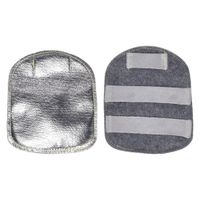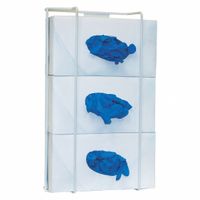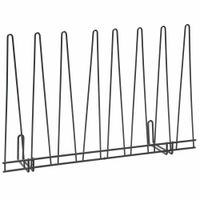Call +(254) 703 030 000 / 751 483 999 / 721 704 777
- Home
- Safety
- Hand Arm Protection
- Glove Dispensers Accessories
.....Read More
Frequently Asked Questions
What are the best materials for glove dispensers?
The best materials for glove dispensers are typically stainless steel, acrylic, and ABS plastic.
Stainless steel is highly durable, resistant to corrosion, and easy to clean, making it ideal for environments requiring high hygiene standards, such as hospitals and laboratories. Its robust nature ensures longevity, even in high-traffic areas.
Acrylic is another popular choice due to its clarity and aesthetic appeal. It allows for easy visibility of the glove supply, ensuring timely refills. Acrylic is lightweight yet sturdy, making it suitable for various settings, including medical facilities and food service areas.
ABS plastic is favored for its cost-effectiveness and versatility. It is impact-resistant and can withstand frequent use without cracking or breaking. ABS plastic dispensers are often used in industrial and commercial settings where budget constraints are a consideration.
Each material offers unique benefits, and the choice depends on the specific requirements of the environment in which the dispenser will be used.
How do you properly maintain and clean glove accessories?
To properly maintain and clean glove accessories, follow these steps:
1. **Read Care Instructions**: Always start by checking the manufacturer's care label for specific cleaning instructions.
2. **Regular Cleaning**: After each use, gently shake out the gloves to remove loose dirt and debris. For leather gloves, use a soft brush or cloth to wipe off dirt. For fabric gloves, a lint roller can be effective.
3. **Washing**:
- **Leather Gloves**: Use a damp cloth with mild soap to wipe the surface. Avoid soaking. Rinse with a clean damp cloth and let them air dry away from direct heat.
- **Fabric Gloves**: Hand wash in lukewarm water with mild detergent. Rinse thoroughly and gently squeeze out excess water. Avoid wringing.
- **Synthetic Gloves**: Machine wash on a gentle cycle if the label permits. Use cold water and mild detergent.
4. **Drying**:
- **Leather**: Reshape while damp and let them air dry naturally. Avoid direct sunlight or heat sources.
- **Fabric and Synthetic**: Lay flat on a towel to air dry. Avoid using a dryer as it can cause shrinkage or damage.
5. **Conditioning**: For leather gloves, apply a leather conditioner periodically to maintain suppleness and prevent cracking.
6. **Storage**: Store gloves in a cool, dry place. Use a breathable bag or box to prevent dust accumulation. Avoid folding leather gloves to prevent creases.
7. **Inspection and Repair**: Regularly inspect for wear and tear. Repair small holes or loose threads promptly to extend the life of the gloves.
8. **Avoid Chemicals**: Keep gloves away from harsh chemicals and oils that can degrade materials.
By following these steps, you can ensure your gloves remain in good condition, providing optimal performance and longevity.
What are the benefits of using glove liners?
Glove liners offer several benefits that enhance the functionality and comfort of wearing gloves. Firstly, they provide an additional layer of insulation, which is particularly beneficial in cold environments. This extra layer helps retain body heat, keeping hands warmer for longer periods. Secondly, glove liners improve moisture management. They wick away sweat from the skin, reducing the risk of dampness that can lead to discomfort or even frostbite in extreme conditions.
Another advantage is the enhanced comfort they provide. Glove liners are typically made from soft, breathable materials that reduce friction between the skin and the outer glove, preventing chafing and irritation. This is especially important for individuals who wear gloves for extended periods.
Glove liners also contribute to better hygiene. They act as a barrier, absorbing oils and sweat from the skin, which helps keep the outer gloves cleaner and extends their lifespan. This is particularly useful in situations where gloves are shared among multiple users.
In terms of dexterity, glove liners can improve grip and tactile sensitivity. They provide a snug fit that allows for better manipulation of objects, which is crucial in tasks requiring precision. Some liners are designed with textured surfaces to enhance grip further.
Additionally, glove liners can offer protection against allergens and irritants. For individuals with sensitive skin or allergies, liners can prevent direct contact with materials that may cause reactions.
Finally, glove liners are versatile and can be used in various settings, from industrial work environments to outdoor recreational activities. They are easy to carry and can be quickly added or removed as needed, making them a practical accessory for anyone who frequently uses gloves.
How do you choose the right size for glove dispensers?
To choose the right size for glove dispensers, consider the following factors:
1. **Glove Size and Type**: Determine the size and type of gloves you will be dispensing. Glove dispensers should accommodate the specific sizes (small, medium, large) and types (latex, nitrile, vinyl) of gloves used in your facility.
2. **Dispenser Capacity**: Assess the volume of glove usage in your setting. High-traffic areas may require larger dispensers or multiple units to ensure a constant supply without frequent refilling.
3. **Space Availability**: Evaluate the available space where the dispenser will be installed. Wall-mounted dispensers save counter space, while countertop models may be suitable for areas with limited wall space.
4. **Dispenser Dimensions**: Check the dimensions of the dispenser to ensure it fits the designated space. Consider the depth, width, and height to avoid obstruction and ensure ease of access.
5. **Installation Type**: Decide between wall-mounted, countertop, or freestanding dispensers based on the layout and workflow of the area. Wall-mounted options are ideal for conserving space, while freestanding units offer flexibility in placement.
6. **Material and Durability**: Choose dispensers made from durable materials like stainless steel or high-quality plastic to withstand frequent use and potential exposure to cleaning agents.
7. **Ease of Use**: Ensure the dispenser design allows for easy glove retrieval and refilling. Features like clear fronts for visibility and wide openings for easy access can enhance usability.
8. **Compliance and Safety**: Ensure the dispenser complies with relevant health and safety regulations, particularly in medical or food service environments.
9. **Aesthetic and Design**: Consider the design and color of the dispenser to match the decor and professional appearance of the facility.
By evaluating these factors, you can select a glove dispenser that meets your operational needs and enhances efficiency.
What are the advantages of wall-mounted glove dispensers?
Wall-mounted glove dispensers offer several advantages, particularly in environments where hygiene and efficiency are paramount.
1. **Space Efficiency**: By mounting on walls, these dispensers free up valuable counter and storage space, making them ideal for areas with limited room. This allows for better organization and utilization of available space.
2. **Accessibility and Convenience**: Positioned at eye level or within easy reach, wall-mounted dispensers ensure that gloves are readily accessible. This convenience encourages frequent glove use, promoting better hygiene practices.
3. **Hygiene and Cleanliness**: Keeping gloves in a dispenser reduces the risk of contamination compared to storing them in open boxes or drawers. The enclosed design protects gloves from dust, moisture, and other contaminants, ensuring they remain clean until use.
4. **Improved Workflow**: In high-traffic areas like hospitals or laboratories, quick access to gloves is crucial. Wall-mounted dispensers streamline workflow by allowing staff to quickly grab gloves without interrupting their tasks, enhancing overall efficiency.
5. **Inventory Management**: These dispensers often have transparent or semi-transparent designs, allowing for easy monitoring of glove levels. This visibility helps in timely restocking, preventing shortages and ensuring a constant supply.
6. **Safety and Compliance**: In healthcare and food service industries, compliance with safety regulations is critical. Wall-mounted dispensers help maintain compliance by ensuring gloves are stored properly and are easily accessible, supporting adherence to hygiene standards.
7. **Durability and Longevity**: Made from robust materials like stainless steel or durable plastics, these dispensers are designed to withstand frequent use and last longer, providing a cost-effective solution over time.
8. **Aesthetic Appeal**: Available in various designs and finishes, wall-mounted dispensers can complement the decor of any setting, contributing to a professional and organized appearance.
How do glove drying racks work?
Glove drying racks are designed to facilitate the drying process of gloves by allowing air to circulate both inside and outside the gloves, thereby speeding up evaporation and preventing moisture retention. These racks typically consist of a series of pegs or arms onto which gloves can be placed. The design ensures that the gloves are held open, allowing air to flow freely into the interior spaces that are often difficult to dry.
The racks are usually made from materials like plastic, metal, or wood, which are resistant to moisture and can withstand repeated use. Some advanced models may incorporate additional features such as fans or heating elements to further expedite the drying process. The airflow, whether natural or assisted, helps to evaporate moisture from the gloves' fabric, reducing the risk of mold, mildew, and odor development.
By keeping the gloves in an open position, the racks prevent the fabric from sticking together, which can trap moisture and slow down drying. This is particularly important for gloves made from materials like leather or thick fabrics, which can take longer to dry if not properly aerated.
In summary, glove drying racks work by holding gloves in a position that maximizes air circulation, thereby enhancing the drying process and maintaining the gloves' shape and integrity.
What are the safety standards for electrical glove accessories?
Safety standards for electrical glove accessories are crucial to ensure the protection of workers handling electrical equipment. These standards are primarily governed by organizations such as the Occupational Safety and Health Administration (OSHA) and the American Society for Testing and Materials (ASTM).
1. **Classification and Rating**: Electrical gloves are classified based on their voltage protection levels. ASTM D120 specifies the standards for rubber insulating gloves, categorizing them into classes ranging from Class 00 (500 volts AC) to Class 4 (36,000 volts AC).
2. **Material and Construction**: Gloves must be made from high-quality insulating rubber. They should be flexible, durable, and resistant to ozone, oil, and other environmental factors. The ASTM D120 standard outlines the physical and mechanical properties required for these gloves.
3. **Testing and Inspection**: Before use, gloves must be tested for electrical integrity. ASTM F496 provides guidelines for in-service care, including visual inspection for physical damage and dielectric testing to ensure no current leakage. Gloves should be tested every six months if in use, and every 12 months if in storage.
4. **Labeling and Marking**: Gloves must be clearly marked with the class, size, and manufacturer details. They should also have a date stamp indicating the last test date.
5. **Use with Leather Protectors**: To prevent mechanical damage, rubber gloves should be worn with leather protectors. The ASTM F696 standard specifies the requirements for these protectors, ensuring they do not compromise the insulating properties of the rubber gloves.
6. **Storage and Maintenance**: Gloves should be stored in a cool, dark place, away from direct sunlight and chemicals. They should be kept in a relaxed position to prevent creasing and damage.
Adhering to these standards ensures the safety and reliability of electrical glove accessories, protecting workers from electrical hazards.





